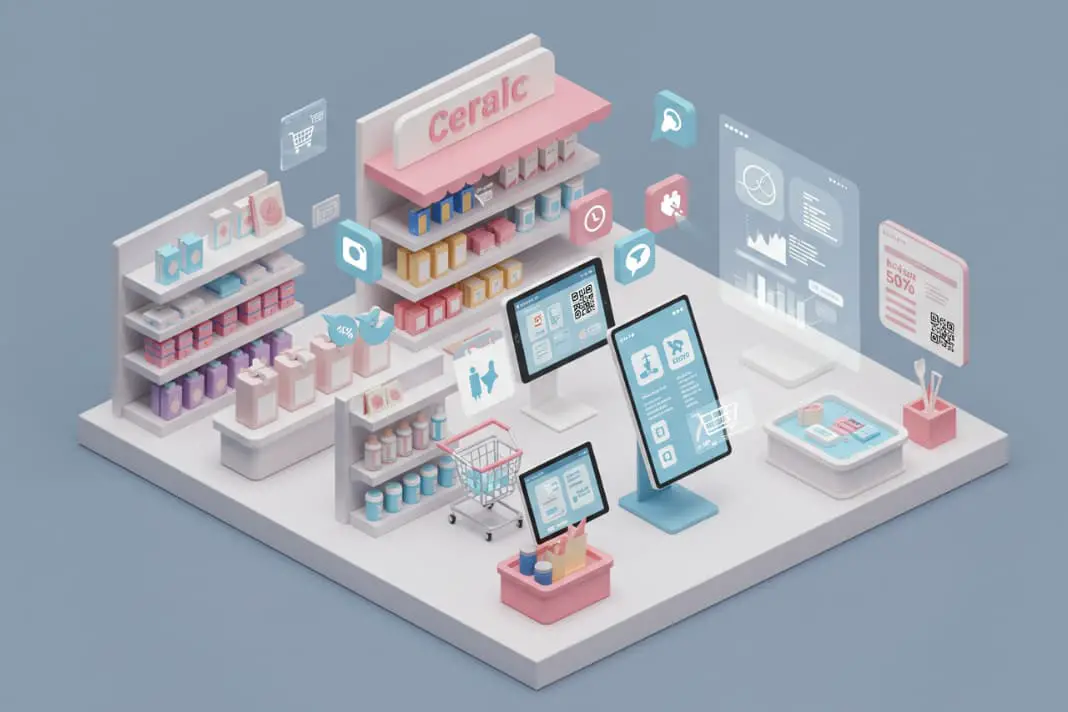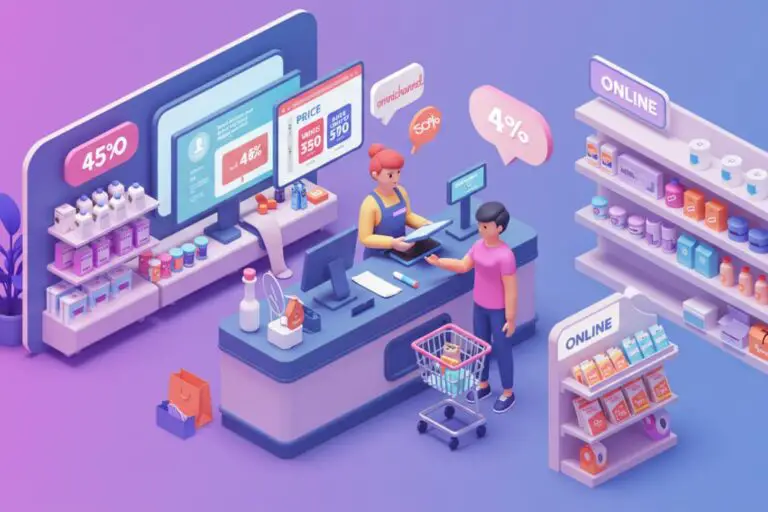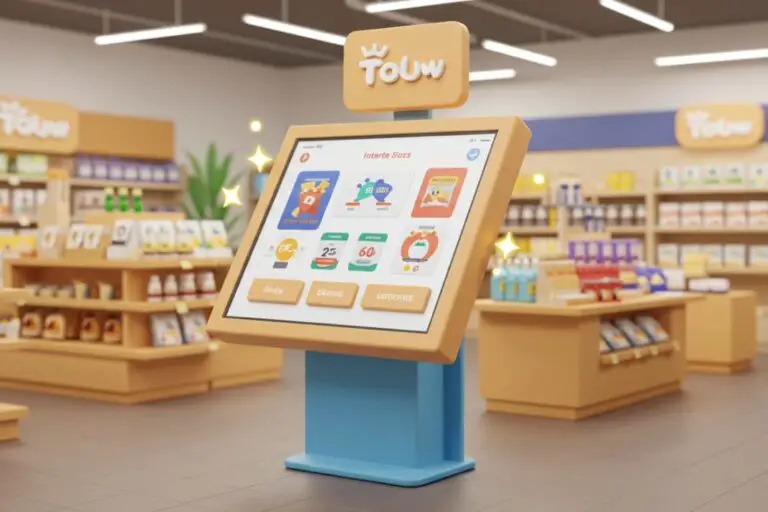Phygital retail is changing how people shop. Stores now blend physical spaces with digital tools to create shopping experiences that feel both familiar and new. The days when shoppers had to choose between visiting a store or buying online are fading. Today’s customers expect the best of both worlds.
The retail industry faces pressure from all sides. Online giants compete for customer attention while shoppers demand more convenience and personalization. Creating a phygital strategy helps stores not just survive but thrive in this challenging landscape.
This shift isn’t just about adding screens to stores. It’s a complete rethinking of how customers interact with products and brands. By connecting physical stores with digital capabilities, retailers can offer shoppers what they truly want: convenience, personalization, and memorable experiences.
1. What is Phygital Retail?
Phygital retail combines the best aspects of in-person shopping with digital tools. The term itself blends “physical” and “digital” into a new approach to retail. Unlike traditional stores that operate separately from their websites, phygital spaces create a single, connected experience.
This approach has evolved over time. First came basic websites, then mobile apps, followed by efforts to connect these physical and digital worlds. Phygital retail takes this further by making the boundaries between online and offline shopping almost invisible.
Shoppers today want the best of both worlds, seeking a personalized shopping experience that blends physical and digital interactions. They value touching products and getting immediate help from store staff. But they also appreciate the convenience, selection, and personalization of online shopping. Phygital retail gives them all these benefits in one seamless experience.
Real-world examples:
Nike’s House of Innovation stores are a prime example of phygital retail, blending physical and digital elements. Shoppers can use their phones to scan mannequins, check product availability, and request items to try on. The Nike App lets customers reserve products and pick them up from smart lockers without waiting in line.
Sephora blends physical and digital through their Virtual Artist feature. In stores, special mirrors let shoppers virtually try hundreds of makeup products without touching their skin. The same tool works on their mobile app, creating consistency between home and store experiences.
2. Key Technologies in Phygital Retail
Several technologies make phygital retail possible. Each serves a specific purpose while working together to create a complete experience.
Connected Stores
Connected stores use sensors and data systems to make shopping spaces smarter. Smart shelves can track inventory in real time, alerting staff when products need restocking. Beacons send personalized offers to shoppers’ phones as they walk through different departments.
Legend World Wide, a retailer in Serbia, demonstrates the power of connected stores. They implemented RFID technology (radio tags that identify items) with the ThingWorx platform. This system tracks which products customers take to fitting rooms versus what they actually buy. This information helps store managers make better decisions about product placement and inventory.
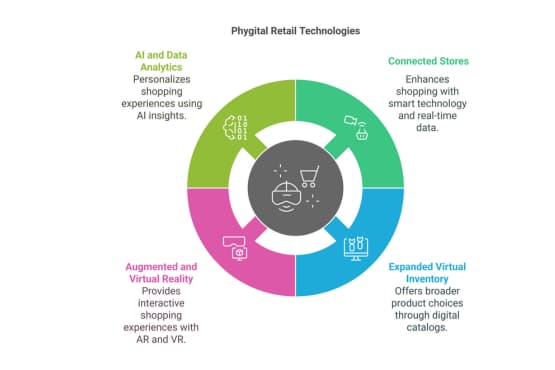
Expanded Virtual Inventory
Physical stores have limited shelf space. Virtual inventory expansion solves this problem by letting customers browse and order items that aren’t physically present. Touch screens or kiosks throughout the store show the complete product catalog, including sizes, colors, and variations not on display.
This approach reduces the need for overstocking while giving customers more choices. Items can be shipped to the customer’s home or picked up in-store later. Retailers save on storage costs while increasing sales opportunities.
Augmented and Virtual Reality
AR and VR technologies create interactive product experiences. Shoppers can use augmented reality to see how furniture would look in their homes, try on clothes without changing, or visualize customized products.
Gucci uses AR technology to let customers virtually try on shoes through their mobile app. This digital fitting room helps shoppers make confident decisions before buying, reducing return rates and increasing satisfaction.
IKEA’s Place app lets customers see exactly how furniture items would fit and look in their homes. The app uses AR to show realistic 3D models of products, properly scaled to the customer’s space.
This helps solve a common furniture shopping problem: uncertainty about how items will look in the home.
AI and Data Analytics
Artificial intelligence powers personalization in phygital retail. By analyzing purchase history and browsing behavior, AI can recommend products that match individual preferences. In-store, this might appear as personalized offers on digital displays or through a store app.
Data analytics helps retailers understand traffic patterns, product performance, and customer behavior. This information guides decisions about store layout, staffing, and inventory management.
Amazon Fresh stores use AI-powered systems to track what customers place in their carts. This technology enables checkout-free shopping, where customers simply walk out when finished, and their accounts are charged automatically.
3. The Phygital Implementation Roadmap
Converting traditional stores into phygital spaces requires careful planning and the integration of digital elements.
Here’s a step-by-step approach for retailers:
Step 1: Assess Current Capabilities
Before making changes, understand what you already have. Map out your current technology systems, customer journey, and pain points. Ask:
- What technology do you currently use in your retail store to bridge the gap between physical and digital worlds?
- How do customers move through your buying process?
- Where do customers get frustrated or abandon purchases?
- What customer data do you already collect?
This assessment reveals gaps and opportunities for improvement.
Step 2: Choose the Right Technologies
Not all phygital technologies fit every retailer. Select tools based on:
- Store size and layout
- Customer demographics and preferences
- Budget constraints
- Business goals (increasing sales, reducing returns, etc.)
Small specialty retailers might start with simple solutions like QR codes linking to online content. Larger department stores might invest in interactive displays and virtual try-on technology.
Step 3: Connect Systems Seamlessly
For phygital retail to work, systems must communicate. Your point-of-sale system needs to connect with your online inventory, customer database, and mobile app. This integration ensures customers have consistent experiences across all touchpoints.
Many retailers work with specialized system integrators to connect legacy systems with newer digital platforms. The goal is to create a single view of inventory and customers across all channels.
Step 4: Train Staff Effectively
Store associates play a crucial role in phygital retail. They need training to:
- Use new technology confidently
- Help customers navigate digital tools
- Understand how online and in-store processes work together
- Access customer information appropriately
Nordstrom invests heavily in staff training for their phygital initiatives. Sales associates carry mobile devices that access customer profiles and purchase history, helping them provide more personalized service.
Step 5: Measure Success
Establish clear metrics to track performance. Common measurements include:
- Foot traffic changes
- Sales lift from phygital initiatives
- Customer satisfaction scores
- Adoption rates of digital tools
- Return rates
- Average transaction value
Regular analysis of these metrics helps retailers refine their phygital strategy over time.
4. Business Impact of Phygital Retail
Phygital retail delivers measurable benefits across multiple areas of business performance.
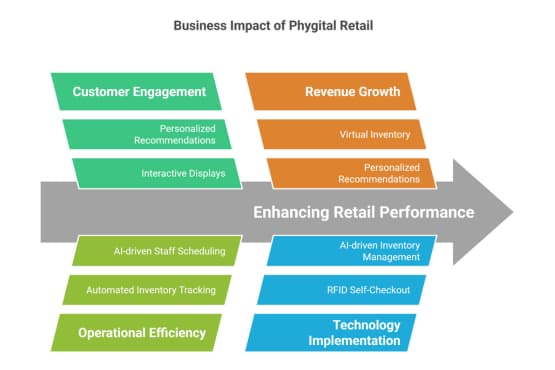
Enhanced Customer Engagement
Phygital experiences create opportunities for deeper customer engagement. Interactive displays, personalized recommendations, and gamified shopping experiences keep customers in stores longer and create memorable brand associations.
The global market for phygital retail solutions reached $25 billion in 2023 and is growing at 11.2% annually. This growth reflects the positive impact these technologies have on customer engagement and sales performance.
Operational Efficiency
Digital integration improves behind-the-scenes operations. Automated inventory tracking reduces manual counting and improves accuracy. Staff scheduling can align with foot traffic patterns predicted by AI systems.
Walmart has implemented AI-driven inventory management across its stores. This system predicts demand patterns and optimizes stock levels. The result: better product availability and reduced waste from overstocking.
Revenue Growth
Perhaps most importantly, phygital retail drives sales growth in several ways:
- Expanded product offerings through virtual inventory create a seamless shopping experience for customers.
- Personalized recommendations that increase basket size
- Reduced abandoned purchases through better availability
- Higher conversion rates from enhanced product information
Research shows that 65% of shoppers now prefer phygital shopping experiences over traditional methods. This preference translates directly to revenue for retailers who meet these expectations.
Decathlon sports stores use RFID technology to enable self-checkout. Customers simply place their selections in a checkout zone where the system reads all items at once. This speeds up the purchase process while reducing staffing needs at registers.
5. Overcoming Challenges in Phygital Transformation
The path to phygital retail comes with obstacles. Here’s how to address the most common challenges:
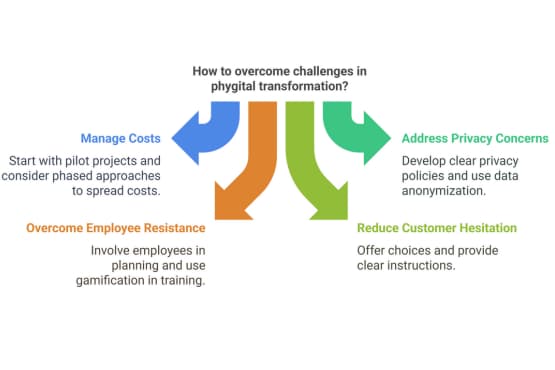
Managing Costs
Challenge: Implementing phygital technology requires significant investment.
Solution: Start with pilot projects in high-impact areas. Measure results carefully and use successful pilots to justify broader implementation. Consider phased approaches that spread costs over time. Look for technology partners who offer subscription models rather than large upfront purchases.
Addressing Privacy Concerns
Challenge: Collecting customer data raises privacy issues.
Solution: Develop clear privacy policies and communicate them to customers. Use data anonymization where possible. Offer meaningful benefits in exchange for data sharing. Follow regulations like GDPR and CCPA carefully.
Retail giant Target learned this lesson the hard way after a data targeting incident. They now focus on transparency, letting customers know what data is collected and how it’s used.
Overcoming Employee Resistance
Challenge: Staff may resist new technology that changes familiar routines.
Solution: Involve employees in the planning process. Create champions who can help train peers. Demonstrate how technology makes their jobs easier or more effective. Use gamification in training to make learning more engaging.
Apple Stores successfully navigate this challenge through extensive employee training. New store technologies are first introduced to staff through hands-on sessions before being used with customers.
Reducing Customer Hesitation
Challenge: Some customers may feel uncomfortable with new technologies.
Solution: Offer choices in how customers engage. Provide clear instructions through signage or staff assistance. Start with intuitive, simple interfaces before introducing more complex features.
Best Buy addresses this through their dedicated customer education programs. Store associates demonstrate new technologies and offer workshops for customers who want to learn more.
6. Measuring Phygital Success
Tracking the right metrics helps retailers understand their return on investment and identify areas for improvement.
Key Performance Indicators
Successful phygital retailers track these essential metrics:
| Metric | What It Measures | Target Improvement |
|---|---|---|
| Conversion Rate | Percentage of store visitors who make purchases | 15-30% increase |
| Average Order Value | Amount spent per transaction | 10-25% increase |
| Dwell Time | How long customers spend in store | 20-40% increase |
| Return Rate | Percentage of purchases returned | 10-30% decrease |
| Net Promoter Score | Customer likelihood to recommend | 15+ point increase |
These numbers vary by retail category. Fashion retailers might see larger improvements in return rates, while electronics retailers might see bigger gains in average order value.
Tools for Measurement
Several tools help collect and analyze performance data:
- Google Analytics 4 tracks website and app performance alongside in-store digital interactions
- Heat mapping software monitors how customers move through physical spaces
- Customer satisfaction surveys capture qualitative feedback
- POS systems provide transaction-level data
- Loyalty programs track individual customer behavior across channels
The most effective approach combines multiple data sources to create a complete picture of customer behavior and business impact.
7. Future Trends in Phygital Retail
The phygital retail landscape continues to evolve. These emerging trends will shape the next wave of innovation:

Voice Commerce
Voice assistants are moving from homes into retail spaces. Customers will use voice commands to find products, check prices, or place orders. Store associates will use voice systems to access information without stepping away from customers.
Web3 Applications
Blockchain technology and NFTs (non-fungible tokens) offer new possibilities for retail. Digital ownership certificates could authenticate luxury goods. NFT-based loyalty programs might offer exclusive benefits to members.
LVMH, the luxury goods conglomerate, has already implemented blockchain authentication for brands like Louis Vuitton and Christian Dior. This technology helps combat counterfeiting while creating new digital customer experiences.
Sustainability Solutions
Environmental concerns drive new phygital applications. Apps that track products’ carbon footprints help eco-conscious shoppers make informed choices. Digital receipts reduce paper waste while capturing customer data.
H&M’s in-store recycling program uses digital tracking to reward customers for bringing in old clothing. The system tracks participation and provides reward points digitally.
5G-Enabled Experiences
The rollout of 5G networks enables faster, more responsive digital experiences in stores. Higher bandwidth supports advanced applications like real-time virtual fashion shows or interactive product demonstrations.
8. Frequently Asked Questions
How does expanded virtual inventory work?
This technology uses in-store kiosks or mobile apps to show products that aren’t physically present in the store. Customers can browse the complete catalog and order items for home delivery or later in-store pickup.
What are connected stores?
Connected stores use sensors, RFID tags, beacons, and cameras to collect data about product movement and customer behavior. This information helps improve store operations and customer experiences.
Can small businesses implement phygital strategies?
Yes. Small retailers can start with simple, affordable solutions like QR codes linking to product information, basic mobile apps, or social media integration. These smaller steps still deliver meaningful benefits.
Which industries benefit most from phygital retail?
Fashion, home goods, beauty, and electronics retailers have seen the strongest results from phygital implementation. However, nearly any retail category can benefit from appropriate digital integration.
Conclusion
Phygital retail represents the future of shopping. By blending physical spaces with digital capabilities, retailers create experiences that meet modern customer expectations while driving business growth.
The most successful retailers approach phygital transformation strategically. They start with clear goals, select appropriate technologies, and measure results carefully. They train staff thoroughly and address customer concerns proactively.
The retail landscape will continue to evolve, but the fundamental principle remains: customers want convenience, personalization, and meaningful experiences. Phygital retail delivers all three.
For retailers ready to begin this journey, the first step is assessing your current capabilities and identifying opportunities for digital integration. Start with targeted pilots in high-impact areas, measure results, and expand based on success.
The phygital future is already here. The only question is whether your retail business will lead the transformation or follow behind competitors.

